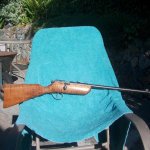In other words, without the chrony data to determine the MV of any group of ammo, we simply cannot know for certain what it is other than to estimate what the overall ES would have to be in order to describe the results achieved down range.
In any case, if I knew of SK Rifle Match with an ES of 35 fps in that regard I would consider it to be very good indeed. Would you agree that if correct the recorded sizes on the eight groups shown above indicate that the groups were very good for SK RM ammo?
To estimate overall ES, one must look at the round that impacted the highest from the center of the bull (whichever group that might be on), and what round impacted lowest from the center of the bull (whichever group that might be on). Add together the distances to center of the bull, to arrive at the maximum vertical spread for all shots fired, and from there the ES may be calculated with a ballistic app, roughly, as we do not know the exact velocity range of the ammo (and being off by only 30 fps for the average MV can change calculated vertical spread by up to an inch). I'm eyeballing 5-5.5" of total vertical spread, or 2.62 MOA. If the velocity range was 1030 to 1080, 50 fps ES, calculated MOA spread is 2.7, good enough for me. The ES of the Rifle Match ammo he shot was approximately 50, + or - a few fps.
Now, it is rare to witness the full ES of a large sample on a single 5 or 10 shot group. I'm not advanced enough in mathematics to try to compose a formula for how much smaller the typical ES would be, but the observed ES on the majority of 5 or 10 shot groups is indeed significantly less than the total ES for the entire sample. Say the ES on the typical group he shot was 35. Going back over my data, I would say No, this is not a good lot of SK RM ammo. I am seeing SK ammo hold sub 25 fps for 10 shots (of course, not all groups, but please see attached chart. My worst 10-shot ES for RM ammo was 35, with the others being 25, 26, 23, and 24. Likewise, Standard + only had one group go over 35 fps.


What does all this mean? Knowing the ES of his ammo gives the shooter only a partial understanding of how the ammo will perform. He can know what the velocity spread might look like over the course of using a large sample size of his ammo. Knowing the SD of his ammo will give the shooter a fuller understanding of how he can reliably expect his ammo to perform. In short, the ES doesn't tell an ammo's complete story, doesn't paint a complete picture of its nature. The SD of an ammo adds much-needed colour.
This is not to suggest that shooters need to chronograph their ammo to know how it will perform. A shooter can simply shoot and see what happens without ever using a chrony. This is what most shooters do, this one included (I have a chronograph but haven't used it in years). If his results are good, he has good ammo. Further, if the results are good, his rifle and shooting are good. But what explains inconsistent results (overlooking for the time the conditions)? Here the shooter is on less sure footing. Is it the ammo, the rifle, the shooter, or a combination of the three (again, disregarding conditions)? Chronographing can help explain the results obtained down range. It doesn't dictate them. The results should be the same regardless whether a chronograph was used. At the same time it's useful to understand why results can be as they are.
I think you've figured out what I was getting at. ES of a large sample only reveals what the "worst case" scenario "might" be. Will it ever be observed in a 5 or 10 shot group? Sometimes, but again, rarely. What shooters can gather from ES is that for a given size of target at long range, they may miss a few times due to the vertical from velocity spread exceeding the size of the target. This is not their fault, it is the nature of the ammo and inherent in the game of trying to hit a target smaller than the rifle/ammo's cone of fire. Too large of a target to accommodate the maximum ammo spread, and there is little challenge to be had trying to hit it. Too small of a target, and hitting it becomes frustrating due to the limitations of the ammo. Rhetorically, how do we select an appropriately sized target?
I am like you, I have largely left the chronograph behind in recent years. Results on target at the 50 yard distance I have been focusing on tell me all I need to know about the ammo. The groups are either tight, or they are not. Nothing to do but try as much quality ammo as possible in search of the desired results. Additionally, there is much more to the achievable precision with a certain ammo than the consistency of velocity alone (which mainly acts on the vertical plane, but can have some slight wind drift implications). Random "fliers" can occur, with the bullet winging off in random directions for seemingly inexplicable reasons. Off axis center of gravity in that bullet? Damage to one side of it? Excessive runout or canted seating to the brass? The list goes on. Good ammo is much more than simply consistent in it's velocity, it is the sum of it's whole construction.









































































